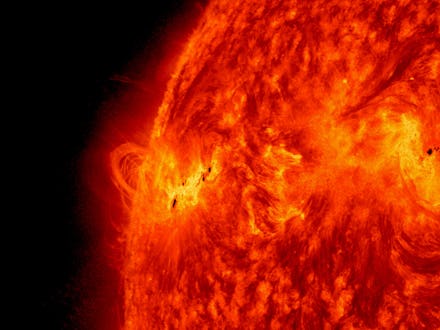The Earth Barely Escaped A Catastrophic Solar Storm, And We're Just Now Finding Out About It

On July 23, 2012, a "a rapid succession of coronal mass ejections — the most intense eruptions on the sun — sent a pulse of magnetized plasma" straight into the Earth's orbit, threatening to disrupt the entire world's electrical and telecommunications grids and send us into a new, temporary dark age.
Fortunately, we were orbiting on the other side of the Sun. Had the Earth been in the "magnetic bullet's" path, writes Science Daily, the results could have been unimaginably devastating as the outburst hit earth's magnetic field, triggering world-wide magnetic storms. Satellites would have gone dark, potentially disabling GPS and global communications. The electrical grid could have malfunctioned and burnt itself out. The closest example in recent history scientists have is the Carrington event of 1859, which knocked out the U.S. telegraph system and actually shocked its operators.
"Had it hit Earth, it probably would have been like the big one in 1859, but the effect today, with our modern technologies, would have been tremendous," said physicist Janet G. Luhmann, who helped detect the storm as part of the STEREO (Solar Terrestrial Observatory) team at UC Berkeley's Space Sciences Laboratory. Her colleague Ying D. Liu, now a professor at China's State Key Laboratory of Space Weather, concurs.
"An extreme space weather storm — a solar superstorm — is a low-probability, high-consequence event that poses severe threats to critical infrastructures of the modern society," he cautioned. "The cost of an extreme space weather event, if it hits Earth, could reach trillions of dollars with a potential recovery time of 4-10 years. Therefore, it is paramount to the security and economic interest of the modern society to understand solar superstorms."
Image Credit: Flickr
This could have been bad: A study released last year calculated the cumulative cost of another Carrington event would be around $2.6 trillion globally, or about 3.2% of the globe's estimated gross world product of $73.87 trillion in nominal terms in 2013. No matter how you slice it, it would be very bad news for the global economy were another such incident to occur.
As Gizmodo writes, such a storm would have also been incredibly beautiful as the magnetic storms discharged their energy across the globe, with glowing auroras in the skies above as the lights flickered out around us. It would have been as visible from Times Square as in the remote stretches of the Andes and Himalayas.
Here's what solar flares look like on the sun:
Safe for now: While planet Earth and its precious telecommunications grids are likely safe for now, occasional solar flare-ups remain a constant fact of our stellar neighborhood. Sooner or later, one of them's going to hit us. And we don't know quite what will happen when it does.
"It's like with earthquakes – it is hard to impress upon people the importance of preparing unless you suffer a magnitude 9 earthquake," says Luhmann.
And according to Liu, "Observations of solar superstorms have been extremely lacking and limited, and our current understanding of solar superstorms is very poor. Questions fundamental to solar physics and space weather, such as how extreme events form and evolve and how severe it can be at the Earth, are not addressed because of the extreme lack of observations."